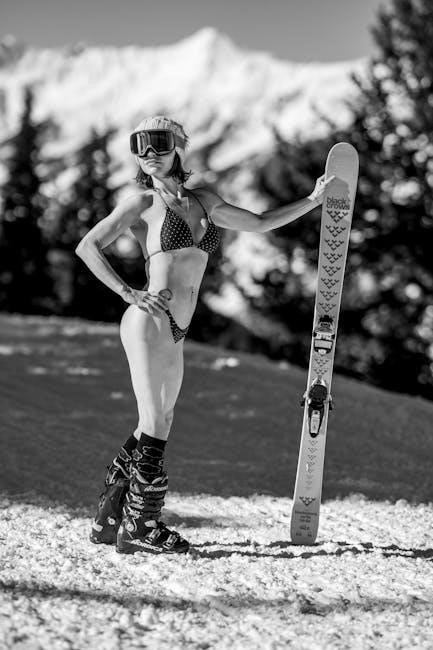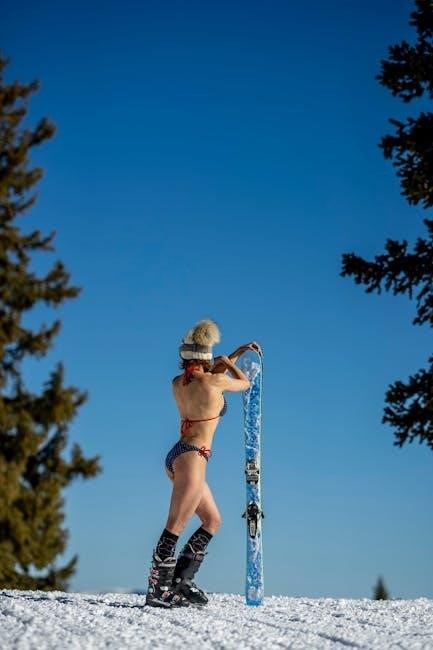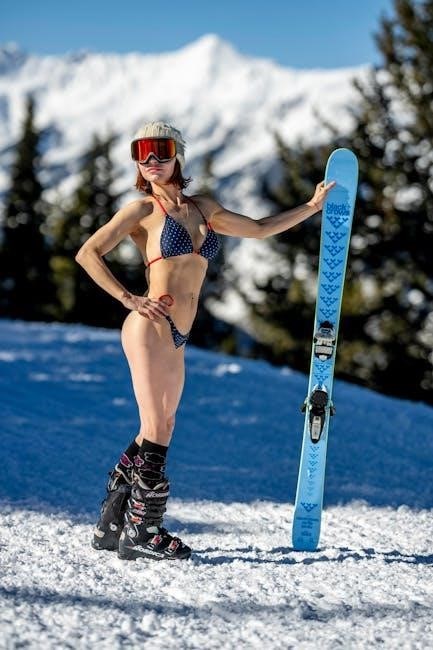Choosing the right ski boots is crucial for optimal performance, comfort, and safety on the slopes․ This guide helps you navigate the process, covering key considerations, types, fit, features, and maintenance to ensure you find the perfect pair for your skiing adventures․
Why Proper Ski Boots Matter
Proper ski boots are essential for a safe, comfortable, and enjoyable skiing experience․ They provide the necessary support, stability, and control, ensuring optimal performance on the slopes․ Ill-fitting boots can lead to discomfort, fatigue, and even injury, while the right pair enhances precision and confidence․ Ski boots act as a critical interface between you and your skis, transferring energy and movements efficiently․ Advanced features like heat-moldable liners, adjustable flex, and innovative closure systems further personalize the fit and performance․ Investing in high-quality, well-fitting boots not only improves your skiing technique but also elevates your overall enjoyment of the sport․ Proper boots are a cornerstone of a successful and memorable skiing adventure․
Overview of the Guide
This comprehensive guide is designed to help you make an informed decision when selecting the perfect ski boots․ It covers essential topics such as understanding your skiing style, assessing your experience level, and setting a budget․ The guide also explores the various types of ski boots, including all-mountain, alpine, freestyle, touring, and race boots, to help you choose the best fit for your needs․ Additionally, it delves into critical factors like fit and sizing, boot flex, liner options, and compatibility with bindings․ Finally, the guide provides insights into popular brands, maintenance tips, and final advice for ensuring a seamless and enjoyable skiing experience․ By following this guide, you’ll be well-equipped to find the ideal pair of ski boots tailored to your preferences and skiing goals․
Key Considerations When Buying Ski Boots
Assess your skiing style, experience level, and budget to narrow down options․ Prioritize fit, comfort, and performance, while considering features like flex, closure systems, and compatibility with bindings․
Understanding Your Skiing Style
Your skiing style significantly influences the type of boots you should choose․ If you’re an all-mountain skier, you’ll need boots that balance performance and versatility․ Alpine skiers prioritize precision and control, often opting for stiffer boots․ Freestyle skiers benefit from more flexible boots for tricks and maneuvers․ Touring enthusiasts require lightweight boots with excellent hike functionality․ Race skiers need ultra-stiff, responsive boots for speed and accuracy․ Assessing your style helps narrow down the best fit, ensuring optimal performance and comfort on the slopes․ Consider how often you ski, the terrain you prefer, and your aggression level to make an informed decision․
Assessing Your Experience Level
Your skiing experience level plays a crucial role in selecting the right boots․ Beginners often benefit from softer flex boots for easier control and forgiveness, while intermediate skiers may prefer a medium flex for balanced performance․ Advanced skiers typically opt for stiffer boots to deliver precise control at higher speeds․ Understanding your experience level helps tailor the boot’s stiffness and features to your needs․ If you’re unsure, consider how often you ski and the terrain you frequent․ Boots designed for your skill level ensure better performance, comfort, and progression․ Self-assessing your ability helps narrow down the ideal boot, whether you’re carving groomers or tackling challenging backcountry trails․
Setting a Budget
Setting a budget is essential when buying ski boots, as prices vary widely based on features, quality, and technology․ Entry-level boots typically range from $200 to $400, offering basic performance for casual skiers․ Mid-range boots, suitable for intermediate skiers, fall between $400 and $700, providing better support and versatility․ Advanced and high-end boots, designed for expert skiers or those seeking premium performance, can cost $700 to $1,200 or more․ Consider your skiing frequency, ability level, and long-term needs when allocating your budget․ While higher-priced boots offer superior features, they may not be necessary for less frequent skiers․ Balancing quality and cost ensures you find boots that meet your needs without overspending․

Types of Ski Boots
Ski boots vary by style, including All-Mountain, Alpine, Freestyle, Touring, and Race boots, each designed for specific skiing needs, offering different flex, features, and performance levels․
All-Mountain Ski Boots
All-Mountain ski boots are the most popular choice, offering versatility for skiers who explore various terrains․ They typically feature a four-buckle overlap design with non-releaseable cuffs, providing a balance of performance and comfort․ These boots cater to a wide range of skiers, from beginners to advanced, with options in narrow, medium, and wide fits․ Flex levels vary to suit different skiing styles, ensuring responsiveness and control․ Recent innovations include the integration of BOA systems, replacing traditional buckles for a snug, customizable fit․ All-Mountain boots are ideal for those who want a reliable, adaptable option for both on and off-piste skiing, making them a top choice for skiers seeking versatility and performance․
Alpine Ski Boots
Alpine ski boots are designed for downhill skiing, offering precision, control, and responsiveness․ They typically feature a four-buckle overlap design with non-releaseable cuffs, providing a snug, performance-oriented fit․ Historically, these boots use aluminum buckles for a secure closure, though recent innovations like BOA systems have been introduced, replacing lower buckles with customizable cable enclosures․ Alpine boots are ideal for skiers who prioritize speed and agility on groomed trails․ They cater to a wide range of skiers, from casual to aggressive, with varying flex levels and fit profiles available․ Whether you’re carving turns or racing down slopes, Alpine boots deliver the support and performance needed for an exhilarating skiing experience․
Freestyle Ski Boots
Freestyle ski boots are designed for skiers who prioritize flexibility and versatility, ideal for tricks, jumps, and exploring varied terrain․ These boots typically feature a softer flex, allowing for easier movement and maneuverability․ Many freestyle boots now incorporate innovative closure systems, such as BOA, which provide a customizable fit without compromising performance․ They often include walk modes, enabling skiers to hike to remote spots or adjust their stance with ease․ Freestyle boots cater to both casual and advanced skiers, offering a balance of comfort and responsiveness․ Whether you’re hitting the park or exploring backcountry features, freestyle boots deliver the freedom and adaptability needed for creative and dynamic skiing experiences․
Touring Ski Boots
Touring ski boots are designed for skiers who seek adventure beyond groomed trails, offering a perfect blend of lightweight construction and performance․ These boots feature hike modes that allow for efficient uphill travel, while still delivering responsiveness on descents․ Many touring boots incorporate innovative materials and systems to reduce weight without sacrificing durability․ They often include gaiter-compatible designs and tech inserts for compatibility with pin bindings, making them ideal for backcountry exploration․ With a focus on versatility, touring boots cater to skiers who value both uphill ease and downhill precision, ensuring a seamless transition between climbing and carving through untouched powder․
Race Ski Boots
Race ski boots are engineered for elite performance, delivering maximum precision and control at high speeds․ Designed for competitive skiers, these boots feature stiff flex ratings to ensure responsiveness and power transmission․ They often have a snug, low-volume fit to minimize movement and maximize energy transfer to the skis․ Advanced materials like carbon fiber are commonly used to reduce weight while maintaining rigidity․ Race boots may also include features like adjustable forward lean and micro-adjustable buckles for a customized fit․ Their focus on performance makes them ideal for racers seeking every edge, though they may be less comfortable for casual skiers due to their high stiffness and tight fit․

Fit and Sizing
Proper fit and sizing are essential for comfort and performance․ Measure foot length, width, and volume․ Try boots on to ensure a snug, responsive fit․ Heat-moldable liners can enhance customization․
How to Measure Your Foot Length and Width
To ensure a proper fit, measure your foot length and width accurately․ Use a Brannock device or trace your foot on paper while standing․ Wear the same socks you’ll use skiing․ Measure both feet, as they may differ slightly․ Note the longest point of your foot for length and the widest part for width․ Consider your foot’s volume, as this affects boot fit․ Accurate measurements help in selecting the right size and style․ Try boots on later in the day, as feet swell․ A well-fitting boot ensures comfort, control, and performance on the slopes․
Importance of Trying Boots On
Trying ski boots on is essential for ensuring a proper fit․ Every brand and model has unique fit profiles, and sizes can vary significantly․ Even if you know your size, trying boots on allows you to assess comfort, support, and how they mold to your foot shape․ Pay attention to pressure points and overall snugness․ Boots should feel tight but not painful, with room to wiggle your toes slightly․ Trying them on later in the day is recommended, as feet tend to swell․ A proper fit ensures better control, performance, and comfort on the slopes․ Don’t rely solely on measurements—personal fit is crucial for an optimal skiing experience․
Understanding Boot Volume
Boot volume refers to the internal space within the boot, encompassing width, height, and overall capacity․ It’s crucial to match your foot shape and skiing style to the boot’s volume for optimal performance․ A boot with too much volume can lead to poor control, while too little can cause discomfort or restrict movement․ Narrow or wide feet may require specific fits, and higher volumes are often preferred for freestyle or touring due to their forgiving nature․ Assessing boot volume ensures a balance between comfort and responsiveness, making it a key factor in your purchase decision․ Proper volume alignment enhances your skiing experience by providing the right level of support and flexibility․
Heat-Moldable Liners

Heat-moldable liners are a game-changer for skiers seeking a customized fit․ These liners can be heated and shaped to conform to your foot’s unique contours, providing exceptional comfort and support․ They are particularly beneficial for skiers with irregular foot shapes or those who experience pressure points․ The molding process typically involves a specialist using a heater to soften the liner, which is then shaped around the foot․ This feature enhances precision and control on the slopes while reducing discomfort during long days of skiing․ While not all skiers may need this level of customization, heat-moldable liners are a valuable option for those prioritizing fit and performance․ They offer a tailored experience that can elevate your skiing enjoyment significantly․
Features to Consider
Key features include boot flex, liner options, buckles, and compatibility with bindings․ These elements enhance performance, comfort, and control, helping you make the right choice for your needs․
Boot Flex and Stiffness
Boot flex and stiffness are critical for performance and comfort․ Softer flex (50-70) suits beginners or casual skiers, offering ease of movement․ Medium flex (70-90) balances responsiveness and forgiveness, ideal for all-mountain skiing․ Stiffer boots (90+) are designed for advanced skiers, delivering precise control at high speeds․ Flex levels vary by brand, so trying boots on is essential; Stiffness affects energy transfer and stability, with stiffer boots providing better edge hold and responsiveness․ Proper flex ensures optimal skiing efficiency, while incorrect stiffness can lead to fatigue or lack of control․ Consider your skiing style, weight, and ability when selecting the right flex for your needs․
Liner Options
Liner options play a significant role in the comfort and performance of your ski boots․ Heat-moldable liners are a popular choice, as they can be customized to fit your foot shape, providing superior comfort and support․ Some liners feature foam or gel padding for added cushioning, while others offer moisture-wicking materials to keep your feet dry․ Custom liners can be purchased separately and molded to your feet for a precise fit․ Stock liners are included with most boots and offer a good balance of comfort and performance․ Upgrading to a high-end liner can enhance your skiing experience by improving fit and reducing fatigue․ Consider your specific needs and preferences when selecting the right liner for your boots․
Buckles and Closure Systems

Buckles and closure systems are essential for securing a snug, responsive fit in ski boots․ Traditional systems often feature aluminum buckles, with two on the upper and two on the lower part of the boot․ However, recent innovations like the BOA closure system have gained popularity, replacing lower buckles with a cable enclosure for a more precise fit․ These systems allow for easy adjustments and a secure hold, ensuring optimal performance․ The number of buckles and their placement can vary, but they all aim to provide a reliable and customizable fit․ Modern designs prioritize durability and ease of use, making it easier to achieve the perfect balance between comfort and responsiveness on the slopes․
Walk Mode and Hike Functionality
Walk mode and hike functionality in ski boots are designed for comfort and mobility when not on skis․ Many modern boots feature a walk mode that allows the cuff to flex, reducing strain on the leg during hiking or walking․ This feature is especially beneficial for skiers who frequently venture off-piste or need to traverse uneven terrain․ Hike functionality often includes a more relaxed forward lean and a softer flex in walk mode, enhancing comfort․ Some boots also incorporate innovative closure systems, like BOA, for easy adjustments․ These designs ensure a balance between downhill performance and uphill ease, making them ideal for adventurous skiers who value versatility and convenience․
Compatibility with Bindings
Ensuring your ski boots are compatible with your bindings is essential for safety and performance․ Most modern ski boots are designed to work with specific binding systems, such as Alpine, AT (alpine touring), or hybrid setups․ Alpine boots typically feature standardized ISO soles, making them compatible with most downhill bindings․ AT boots often have tech fittings for lightweight bindings used in backcountry skiing․ Hybrid boots may offer both options․ Always check the compatibility of your boots with your bindings before purchasing, as mismatched systems can lead to poor performance or safety risks․ This step ensures a seamless connection between your boots and skis, optimizing control and responsiveness on the slopes․
Popular Ski Boot Brands
Top brands like Salomon, Atomic, Nordica, Head, and Dalbello are trusted for their innovative designs, superior comfort, and performance, catering to various skiing styles and preferences․
Salomon Ski Boots
Salomon is a renowned brand in the skiing world, offering high-performance boots that combine innovation, comfort, and durability․ Known for their cutting-edge technology, Salomon boots feature customizable liners, precise fit systems, and advanced flex control․ The Custom Heat system ensures optimal warmth, while Surelock technology provides a secure and responsive fit․ Salomon caters to all skiing styles, from all-mountain adventures to freestyle tricks, with models like the X Pro and QST Access․ Their commitment to sustainability and quality makes them a favorite among skiers of all levels, ensuring a superior on-snow experience․ Whether you’re carving groomers or exploring backcountry, Salomon boots deliver unmatched performance and comfort․
Atomic Ski Boots
Atomic is a leading brand in ski boots, known for their innovative designs and high-performance features․ Their boots are crafted with cutting-edge technology, such as Memory Fit, which ensures a precise, customizable fit․ The Prolite construction reduces weight while maintaining durability, making Atomic boots ideal for both all-mountain and race skiing․ Models like the Hawx and Redster series offer exceptional comfort and responsiveness, catering to skiers of all levels․ Atomic boots also feature progressive flex, providing smooth control and energy transfer․ Whether you’re carving down groomers or tackling challenging terrain, Atomic boots deliver unmatched performance, comfort, and reliability, making them a top choice for skiers worldwide․
Nordica Ski Boots
Nordica is a trusted name in the ski industry, offering high-performance boots that blend innovation and comfort․ Known for their anatomical shell design, Nordica boots provide a precise fit and exceptional responsiveness․ The Pro Machine series is popular among advanced skiers, delivering stiff flex and powerful performance for challenging terrain․ For intermediate skiers, the Sportmachine line offers a more forgiving flex with a comfortable, customizable fit․ Nordica also excels in all-mountain and freestyle categories, with boots like the Navigator, designed for versatility and ease of use․ Their True Comfort technology ensures warmth and a snug fit, making Nordica boots a top choice for skiers seeking both performance and comfort․
Head Ski Boots
Head Ski Boots are renowned for their innovative technology and exceptional performance on the slopes․ The brand offers a wide range of models, from high-performance race boots to versatile all-mountain options․ Head’s Energy Backbone technology enhances responsiveness and power transmission, while their Form Fit liners provide a customizable and comfortable fit․ The Nexo and Next series are popular choices, catering to both advanced skiers and those seeking a more forgiving flex; Head boots are also known for their thermoformable liners, ensuring warmth and a tailored fit over time․ Whether you’re carving groomers or exploring off-piste terrain, Head Ski Boots deliver precision, comfort, and reliability, making them a favorite among skiers of all levels․
Dalbello Ski Boots
Dalbello Ski Boots are celebrated for their innovative designs and exceptional comfort․ Known for their three-piece cabrio design, Dalbello boots offer a unique blend of flexibility and responsiveness, making them ideal for skiers seeking both performance and ease of use․ The brand caters to a wide range of skiing styles, from freestyle to all-mountain adventures․ Dalbello’s Dynamic Performance technology ensures precise control, while their Low Cuff models provide enhanced mobility for freestyle maneuvers․ The Il Moro and Krypton series are particularly popular, offering a balance of power and comfort․ Dalbello boots also feature customizable heat-moldable liners for a tailored fit, ensuring skiers can enjoy a day on the slopes with confidence and style․

Maintenance and Care
Regular cleaning, proper storage, and timely replacement are essential for extending the life of your ski boots․ Clean boots after each use to prevent damage and odors․

Cleaning Your Ski Boots
Regular cleaning is essential to maintain the performance and longevity of your ski boots․ After each use, wipe down the exterior with a soft cloth to remove dirt and snow; For tougher stains, use a mild soap solution, but avoid harsh chemicals that can damage materials․ Pay attention to the buckles and hinges, as debris can accumulate and affect functionality․ Allow the boots to air dry naturally, away from direct heat sources, to prevent warping or cracking; For the liners, remove them and let them dry separately․ Regular cleaning prevents odors and ensures your boots remain comfortable and functional for future skiing adventures․
Storing Your Ski Boots
Proper storage is key to maintaining the condition and performance of your ski boots․ After cleaning, store them in a cool, dry place away from direct sunlight to prevent material degradation․ Avoid storing boots in damp environments or ski bags, as moisture can lead to mold and odor․ Remove the liners and store them separately to ensure proper airflow and drying․ Use a boot bag or wrap them in a soft cloth for protection․ Never store boots with extreme temperatures or humidity, as this can damage plastics and liners․ Regular storage maintenance ensures your boots remain in prime condition for future skiing adventures․
When to Replace Your Boots
Knowing when to replace your ski boots is essential for maintaining performance and comfort․ If your boots show significant wear, such as a worn-out sole, cracked plastic, or a delaminated shell, it’s time to consider a new pair․ The liners losing their shape or the cuff becoming too flexible are also signs of needing replacement․ Typically, high-quality boots last 5-7 years, but this depends on usage and conditions․ If you notice reduced responsiveness or discomfort, even after adjustments, it’s likely time for a upgrade․ Additionally, advancements in technology may make newer boots more appealing․ Replace your boots when they no longer meet your skiing needs or fit properly․
Concluding your ski boot journey, remember that proper fit, performance, and comfort are key․ Invest time in selecting the right pair to elevate your skiing experience․
Final Tips for Choosing the Right Boots
When selecting ski boots, prioritize fit and comfort above all else․ Ensure proper sizing by trying boots on with the same socks you’ll wear skiing․ Consider your skiing style and terrain preferences to narrow down options․ Don’t hesitate to seek advice from professionals at a specialty shop, as they can offer personalized recommendations․ Additionally, explore features like heat-moldable liners and adjustable flex for a customized fit․ Lastly, remember that higher price doesn’t always mean better performance—focus on what meets your specific needs․ By taking these steps, you’ll find boots that enhance your skiing experience and keep you performing at your best․
Enjoy Your Skiing Experience
With the right ski boots, you’re ready to embrace the thrill of the slopes; Proper fit and comfort ensure a seamless connection between you and your skis, allowing you to perform at your best․ Remember, advancements in technology, like heat-moldable liners and BOA systems, are designed to enhance your experience․ Always wear the same socks you plan to ski in when trying boots on, and don’t skip the on-snow test if possible․ Once you’ve found your perfect pair, maintain them by cleaning and storing them properly․ By investing time in selecting and caring for your boots, you’ll enjoy countless days of skiing with confidence and joy․ Happy skiing!